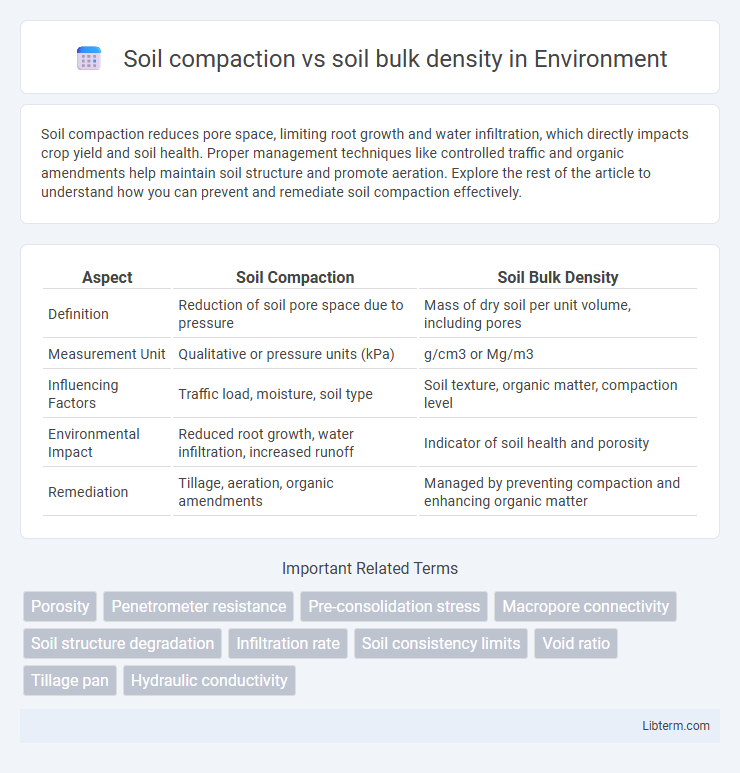Soil compaction reduces pore space, limiting root growth and water infiltration, which directly impacts crop yield and soil health. Proper management techniques like controlled traffic and organic amendments help maintain soil structure and promote aeration. Explore the rest of the article to understand how you can prevent and remediate soil compaction effectively.
Table of Comparison
| Aspect | Soil Compaction | Soil Bulk Density |
|---|---|---|
| Definition | Reduction of soil pore space due to pressure | Mass of dry soil per unit volume, including pores |
| Measurement Unit | Qualitative or pressure units (kPa) | g/cm3 or Mg/m3 |
| Influencing Factors | Traffic load, moisture, soil type | Soil texture, organic matter, compaction level |
| Environmental Impact | Reduced root growth, water infiltration, increased runoff | Indicator of soil health and porosity |
| Remediation | Tillage, aeration, organic amendments | Managed by preventing compaction and enhancing organic matter |
Understanding Soil Compaction: Definition and Causes
Soil compaction occurs when soil particles are pressed together, reducing pore space and limiting air, water, and nutrient movement essential for plant growth. It is closely related to soil bulk density, which measures the mass of soil per unit volume, with higher bulk density indicating greater compaction levels. Common causes of soil compaction include heavy machinery traffic, livestock trampling, and intense rainfall, all of which increase pressure on soil structure and degrade its physical properties.
Soil Bulk Density: Meaning and Measurement
Soil bulk density refers to the mass of dry soil per unit volume, typically expressed in grams per cubic centimeter (g/cm3), and is a critical factor in determining soil porosity and its ability to retain water and nutrients. Measurement of soil bulk density involves collecting a known volume of undisturbed soil using a core sampler, drying the sample at 105degC to remove moisture, and then weighing it to calculate the ratio of dry mass to volume. Lower bulk density values generally indicate better soil structure with higher porosity, while higher bulk density signifies soil compaction, reducing root growth and decreasing soil aeration and water infiltration.
The Relationship Between Soil Compaction and Bulk Density
Soil compaction directly increases soil bulk density by reducing pore space between soil particles, leading to decreased aeration and water infiltration. Bulk density serves as a critical indicator of compaction severity, with values above 1.6 g/cm3 typically signaling restricted root growth and compromised soil health. Monitoring bulk density changes helps assess the extent of compaction and guide soil management practices to restore optimal soil structure.
Key Factors Influencing Soil Compaction
Soil compaction is heavily influenced by soil bulk density, which measures the mass of soil per unit volume and increases as soil particles are pressed closer together. Key factors affecting soil compaction include soil texture, moisture content, and the intensity of mechanical pressure applied by agricultural machinery. High clay content, optimal moisture levels near field capacity, and frequent heavy traffic exacerbate compaction, reducing pore space and limiting root growth and water infiltration.
How Soil Texture Affects Bulk Density
Soil texture significantly influences soil bulk density by determining the proportion of sand, silt, and clay particles, which affects pore space and soil compaction. Sandy soils typically exhibit higher bulk density due to larger particle sizes and less surface area, leading to reduced pore space, while clay soils have lower bulk density because of smaller particles and higher porosity. The balance of soil texture components dictates the extent of soil compaction and its impact on root growth and water infiltration.
Impacts of Soil Compaction on Plant Growth
Soil compaction significantly increases soil bulk density, reducing pore space essential for root penetration and water infiltration. Elevated soil bulk density limits oxygen availability and restricts root development, directly impairing nutrient uptake and overall plant growth. These conditions result in stunted crops, reduced biomass, and lower agricultural productivity.
Effects of High Bulk Density on Soil Health
High soil bulk density reduces pore space, limiting water infiltration, root growth, and air exchange critical for soil microorganisms. Elevated bulk density causes soil compaction, which decreases soil permeability and nutrient availability, leading to poor plant development and reduced crop yields. Maintaining optimal bulk density is essential for preserving soil structure, enhancing microbial activity, and promoting sustainable soil health.
Methods for Assessing Soil Compaction and Bulk Density
Soil compaction and soil bulk density are assessed using methods such as the core method, which involves extracting soil samples with a known volume to measure mass and calculate bulk density accurately. Penetrometers, like the cone penetrometer, gauge soil resistance to penetration, providing indirect but rapid estimates of soil compaction levels in field conditions. Advanced techniques including ground-penetrating radar and X-ray computed tomography offer detailed insights into soil structure and compaction by visualizing pore space distribution and soil particle arrangement.
Strategies to Prevent and Remedy Soil Compaction
Effective strategies to prevent soil compaction include minimizing heavy machinery use on wet soils, implementing controlled traffic farming, and incorporating cover crops to improve soil structure. To remedy existing compaction, deep tillage or subsoiling can break compacted layers, while organic matter amendments enhance porosity and microbial activity. Maintaining optimal soil bulk density, typically below 1.4 g/cm3 for agricultural soils, ensures sufficient aeration and root growth, promoting overall soil health and crop productivity.
Best Practices for Managing Soil Bulk Density in Agriculture
Soil bulk density, a measure of soil mass per unit volume, directly impacts root growth and water infiltration, making it essential to manage for optimal crop yield. Best practices for managing soil bulk density in agriculture include minimizing heavy machinery traffic, employing controlled traffic farming (CTF) systems, and incorporating organic matter to improve soil structure and porosity. Regular monitoring using bulk density tests enables farmers to implement timely interventions such as deep tillage or cover cropping to prevent soil compaction and maintain healthy soil ecosystems.
Soil compaction Infographic

 libterm.com
libterm.com